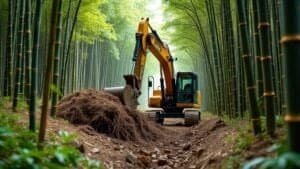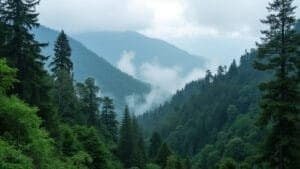Red pandas are fascinating creatures adapted to thrive in the cool, temperate forests of the Himalayas and surrounding mountain ranges. But how does the climate in red panda habitats affect their behavior? The answer lies in their unique adaptations to both seasonal and daily temperature shifts. These mammals, known for their crepuscular activity, adjust their foraging and resting patterns in direct response to their environment
From seeking cooler altitudes during the summer to curling up with their bushy tails in winter, red pandas exhibit finely tuned behaviors that ensure their survival in the face of fluctuating conditions. This article explores the key climate characteristics of their native habitats, the specific behavioral strategies they employ to regulate body temperature and energy, and the growing threat posed by climate change
Climate Characteristics of Red Panda Habitats

Red pandas are highly specialized to survive in a narrow climatic range, which directly influences their behavior, physiology, and habitat preference. These mammals primarily inhabit the temperate forests of the Eastern Himalayas, including Nepal, Bhutan, India, northern Myanmar, and southwestern China
The key to understanding how red pandas behave lies in examining the specific environmental conditions they rely on—particularly temperature, precipitation, altitude, and vegetation patterns. These factors are not just background features of their ecosystem; they are critical in shaping the species’ evolution and daily life
Average Temperature and Precipitation in Red Panda Environments
Red panda habitats are defined by relatively mild, stable temperatures and high levels of humidity throughout the year. These animals are most commonly found in regions where the average annual temperature remains between 50°F and 75°F (10°C to 24°C). In places like Nepal’s Langtang National Park and Sikkim in India, this range allows red pandas to thrive without facing extreme heat or prolonged cold
According to the Red Panda Network, their optimal thermal zone lies between 63°F and 77°F. This makes them particularly sensitive to both excessive heat and intense cold, limiting the altitudinal and latitudinal range where they can comfortably live
These areas receive significant precipitation, often between 60 to 120 inches annually, largely concentrated during the monsoon season. Moisture is a defining feature of red panda habitats, as it supports the lush understory of bamboo that makes up most of their diet. The presence of cloud forests with dense canopies and thick mosses adds to the unique microclimate in which these animals thrive. Because their fur is adapted to cold and wet conditions, red pandas have trouble tolerating hot, dry environments and require forests that maintain high humidity
Temperature not only influences red panda comfort levels but also affects their daily and seasonal activity. A study published in Animals (2023) found that red panda movement patterns correspond closely to ambient temperatures, with peak activity during early morning and late evening when conditions are cooler. During warmer parts of the day, red pandas often reduce activity, seeking shaded tree canopies or high branches where cooler air circulates
Geographic and Elevation Distribution in the Himalayas and Beyond
Red pandas are mainly distributed across the temperate forests of the Himalayas, typically at elevations ranging from 7,200 to 13,800 feet (2,200 to 4,200 meters). In China, they are found in the provinces of Sichuan, Yunnan, and Tibet, where these same forested conditions exist. Elevation is a critical factor because it directly determines the microclimate—cooler temperatures and increased humidity are more prevalent at higher altitudes. This makes elevation both a refuge and a boundary for red pandas
During warmer months, especially in lower elevation zones, red pandas often migrate to higher altitudes to escape rising temperatures. These seasonal elevation shifts were documented by the World Wildlife Fund (WWF), which noted how climate change could force red pandas into higher, narrower bands of habitat with limited resources and increased fragmentation. As a result, the climb to cooler zones becomes both a necessity and a survival risk
Deforestation and habitat fragmentation further complicate this dynamic. According to the IUCN, red panda populations are under increasing threat as their habitats are broken up by human development. These disruptions limit the continuity of suitable altitude zones and prevent red pandas from making necessary seasonal migrations. The trend is exacerbated by global warming, which is pushing the habitable zones higher while simultaneously reducing available territory
In this context, a deeper understanding of red panda habitats becomes more than a matter of academic interest. For a more detailed view of how rising temperatures are affecting red panda behavior and habitat choice, readers can consult this article on summer survival, which highlights the behavioral strategies red pandas adopt during heat waves
Behavioral Adaptations of Red Pandas to Temperature Changes

Red pandas exhibit a fascinating range of behavioral responses tailored to the temperature variations in their mountain forest habitats. These behaviors are not merely routine actions—they are essential strategies that allow red pandas to maintain homeostasis, manage energy, and optimize survival
Their crepuscular habits, thermoregulation techniques, and seasonal shifts in activity all showcase how this species has evolved in close alignment with its environment. Each behavior is a reflection of the climatic pressures faced in the Himalayas and serves to minimize stress and energy loss
Thermoregulation Techniques in Heat and Cold
Thermoregulation is one of the most vital survival strategies for red pandas, especially given their vulnerability to heat. Their thick double-layered fur is designed to insulate them against cold, wet conditions, but it can easily cause overheating when temperatures rise above their preferred range of 63°F to 77°F. To counteract this, red pandas adopt a series of behavioral adjustments
In warmer months, red pandas seek out shaded, elevated perches in the tree canopy where air circulation is better and direct sunlight is minimized. They often sprawl flat on tree branches, a behavior that maximizes surface area contact with cooler surfaces to aid in heat dissipation. When heat becomes excessive, they may also pant—a mechanism rarely seen in colder months—helping to regulate body temperature via evaporative cooling
By contrast, in colder seasons, red pandas engage in energy-conserving postures. They sleep curled into a ball, wrapping their tails around their faces to insulate against the cold and reduce heat loss. A study published in Integrative and Comparative Biology (Roberts & Gittleman, 1984) observed that red pandas reduce metabolic activity without entering torpor, maintaining body temperature while minimizing energy expenditure. This efficient thermoregulation, aided by behavioral adaptations, allows them to remain active year-round, even in subfreezing temperatures
Activity Patterns in Response to Climate
Red pandas are primarily crepuscular—most active during dawn and dusk—which aligns with the cooler parts of the day. This pattern minimizes energy loss from heat exposure and allows them to forage and move when temperatures are more comfortable. In the wild, studies have found they exhibit a third activity peak around midnight, likely tied to feeding cycles and predator avoidance strategies
Temperature fluctuations play a significant role in determining when red pandas engage in various behaviors. During hot summer days, they often remain immobile for long periods, conserving energy and avoiding overheating. Conversely, in cooler weather, they exhibit more extended periods of activity, including grooming, climbing, and feeding. These seasonal variations are consistent with findings from the Animals journal (2023), which tracked movement and activity across several red panda habitats and confirmed increased behavioral shifts during warm weather
Interestingly, red pandas in zoos show altered activity patterns due to climate-controlled environments. They may be more active during the daytime—synchronizing with human visitation schedules—though this behavior deviates from their natural circadian rhythm. The absence of real environmental cues in captivity often leads to subtle changes in activity timing and thermoregulation, as explored in a behavioral review by Freedom for Animals
Seasonal Changes in Movement and Feeding Habits
Seasonal transitions bring dramatic changes to red panda behavior, particularly in terms of feeding and mobility. Bamboo, their primary food source, is available year-round but can vary in nutritional value depending on season and shoot maturity. During spring and early summer, when bamboo shoots are more nutritious and palatable, red pandas increase foraging activity. In winter, they rely on mature leaves, which are less digestible, resulting in a decrease in feeding time and a corresponding drop in activity levels
Red pandas may also adjust their territory range seasonally. As summer heat rises, they migrate to higher altitudes where temperatures are lower and forest cover is denser. This elevation shift, supported by observational data from the Red Panda Network and WWF, demonstrates how climate-induced habitat pressures are prompting behavioral mobility. These seasonal migrations help red pandas access cooler microclimates and fresher bamboo sources, although habitat fragmentation increasingly restricts this behavior
In autumn and winter, red pandas become less mobile, conserving energy by remaining within smaller home ranges and reducing movement. The change is not just physiological but behavioral—characterized by prolonged rest periods and increased use of tail-wrapping to retain warmth
To learn more about how these behaviors align with broader ecological adaptations, the Red Panda Facts article provides further insights into their arboreal lifestyles and crepuscular nature
Effects of Climate Change on Red Panda Survival

The interplay between red pandas and their environment is delicately balanced, but climate change is tipping that balance in potentially irreversible ways. The warming of the Himalayan region, where red pandas predominantly reside, is happening faster than the global average. This rapid environmental shift affects everything from bamboo growth cycles to habitat viability, compelling red pandas to adapt or perish
As these environmental pressures mount, researchers and conservationists are witnessing behavioral and ecological changes that could define the species’ long-term survival prospects
Habitat Shifts and Elevation Migration
One of the most direct consequences of rising temperatures is the upward migration of red panda populations. These animals rely on a specific climatic envelope—cool, moist forest environments found at mid to high elevations, typically between 7,200 and 13,800 feet. As lower altitude zones warm beyond the species’ thermal comfort zone, red pandas are increasingly forced to move higher
This migration, however, comes with trade-offs. The availability of suitable forested land at higher elevations is limited, often fragmented by human settlements, agriculture, and deforestation. According to research published by the World Wildlife Fund (WWF), these habitat corridors are becoming dangerously narrow, isolating red panda populations and reducing genetic diversity. The shrinking habitat range also puts them at greater risk from predators and limits access to bamboo, their primary food source
Moreover, high-altitude areas do not always provide the dense understory bamboo cover found at lower levels. As red pandas climb higher in search of cool temperatures, they may encounter ecological zones that no longer meet their dietary and shelter needs. This phenomenon—where suitable climate zones shift faster than ecosystems can adapt—is known as “climate velocity,” and it’s a growing concern for high-elevation species like the red panda
Impact on Bamboo Availability and Ecosystem Interactions
Red pandas are almost entirely dependent on bamboo, which comprises over 90% of their diet. This plant is highly sensitive to climatic changes, particularly shifts in temperature and precipitation patterns. Studies from the International Centre for Integrated Mountain Development (ICIMOD) have shown that increased heat and erratic rainfall can reduce bamboo productivity and regeneration rates
Bamboo’s sensitivity to environmental changes makes it a limiting factor for red panda survival. Reduced bamboo cover forces red pandas to expand their range in search of food, increasing their exposure to predators and human activity. Climate-induced bamboo die-offs, already observed in some parts of China and Nepal, pose a serious risk, especially during breeding seasons when lactating females need high-energy food sources
In addition to food scarcity, red pandas are also impacted by changes in broader ecosystem interactions. For example, warming temperatures can shift predator ranges or increase disease prevalence. New species may move into higher altitudes, competing with red pandas for food or altering forest dynamics in ways that indirectly affect their survival
Differences in Captive Versus Wild Red Panda Behavior
While wild red pandas must contend with the full force of climate variability, those in captivity live in controlled environments that shield them from direct climate stress. As a result, behavioral differences emerge. In zoos, temperature and humidity are carefully managed, allowing red pandas to maintain regular feeding and activity schedules without the need for migration or thermoregulatory adaptations
However, this artificial stability can lead to reduced physical activity, as the need for energy conservation or adaptive movement is minimized. For example, captive red pandas may not engage in elevation-based migration or extensive foraging behavior, and their sleeping and activity cycles may align more with human interaction patterns than natural circadian rhythms
Despite these differences, zoos and breeding centers play a critical role in conservation. They serve as genetic reservoirs and offer a controlled setting to study red panda physiology and behavior under varied temperature conditions. This data becomes increasingly valuable as researchers seek to understand how the species might cope with future environmental extremes
For further exploration into how warming climates alter red panda physiology and behavior, the Red Panda Network’s feature on heat adaptation offers in-depth insights into these challenges and ongoing conservation strategies












